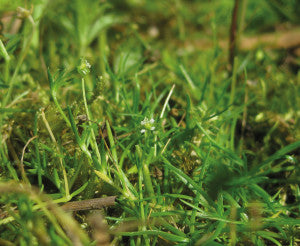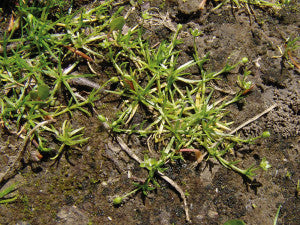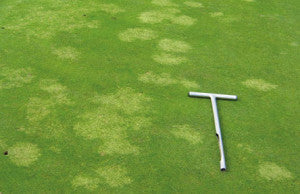Weed of the month: Pearlwort (Sagina procumbens)

Weeds are very good competitors and take advantage of any opportunities to colonise turf situations, particularly when the sward is under stress and weak, leaving bare soil areas for weeds to populate.
Weeds have many mechanisms and characteristics that enable them to do this, having thick waxy cuticle leaves that can be resistant to some chemicals, fast reproduction methods, the ability to reseed in six week cycles and deep tap roots, enabling the weed to survive in compacted dry ground conditions.
Weeds have one of three life cycles: annual; biennial or perennial.
Annual weeds: Live for a single season. These weeds germinate from seed in the spring or summer, flower and then die.
Biennial weeds: Live for two seasons. During the first growing season, these weeds remain in a vegetative stage and, in the following year, produce flowers, set seed and die.
Perennial weeds: Live for multiple seasons and flower more than once. Perennial structures (rhizomes, stolons, crowns, entire plants or roots) survive from year to year.
Some weeds may be harmful to the environment or noxious to your regional ecology. For example, Japanese Knotweed (Fallopia Japonica) is fast becoming a major weed problem on roadside verges and urban landscape areas, a very difficult weed to eradicate. It is very important to recognise weeds and seek effective controls methods to eradicate them from our facilities.
Weeds can also be used as an indicator of soil conditions. For example, knotweed and plantains both indicate soil compaction, because they can maintain adequate root respiration at lower oxygen diffusion levels than other plants. Different weeds tolerate different soil conditions, some are alkaline loving and others acid loving. Getting to understand and recognise the physiology of these plants will help you become better turfgrass managers.
Scientific name: Sagina procum

Family: Caryophyllaceae
Life cycle: Perennial
Form / Appearance: Pearlwort is a perennial mat-forming plant with narrow leaves and tiny white flowers. Pearlwort can become a troublesome weed when allowed to spread and establish in turf. This weed can populate most soil conditions very quickly by seed. Pearlwort is a good indicator of moist/wet conditions and is often mistaken for moss in lawns. Swards that are maintained at low mowing heights, below 6mm (golf and bowling greens), are susceptible to invasion from this weed.
Pearlwort easily develops rooting structures from its stem nodes, producing fine-like roots that can invade most soil conditions. Flowers are white and small and inconspicuous and are seen flowering from April to September. The flowers are generally found on long stems near the tips of the branches. Leaves are very narrow and thin, having quite a thick cuticle which enables Pearlwort to be resistant to weed killers. Leaves are linear; the upper leaf surface is mostly smooth. Leaves are opposite and may appear whorled around the stem.
Pearlwort produces an incredible number of small seeds which can be spread by mowing and foot traffic. Pearlwort also spreads as foliage grows across the soil surface, rerooting at the internodes. Seedlings emerge from soil with foliage that looks identical to mature foliage.
Pearlwort is commonly found in coastal areas and in areas of moist, frequently irrigated turf. It can form prostrate to mounding clumps 5cm in height, and has often been sold as a ground covering plant material for landscaping.
Pearlwort is often associated with excess water in containerised plants. Pearlwort is in the Pink family, and thus closely related to carnations and dianthus plants. Its growth habit is a dichasial cyme, distinct of that family.

of the turf, aeration, feeding and regular mowing will ensure that the sward remains dense, reducing the opportunity of bare soil becoming a seedbed for Pearlwort.
Spray with a systemic herbicide containing 2,4-D that is absorbed through the leaves of the plant, the active ingredient makes its way through the cells of the plant down to the root. It kills these first and then the foliage starts to die off. Pearlwort is a persistent weed and may need further applications of herbicide; review the product label to assess how many times it can be applied and over what time frame.
Apply the selective herbicides when plant growth is active. There are a number of products available for controlling broadleaved weeds in established turf. These herbicides are best used when the weeds are actively growing, usually between May-September.
A range of weed killers are available in the Pitchcare Shop
Author: Laurence Gale, Pitchcare Editor
